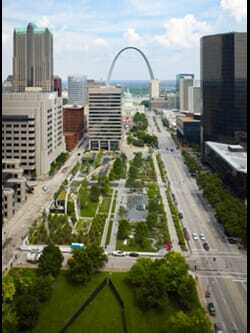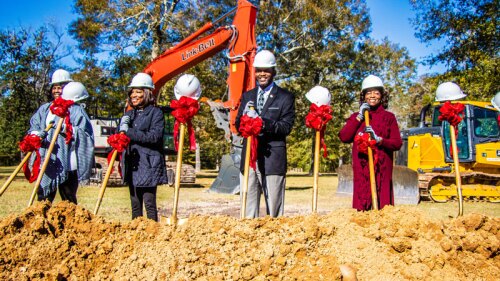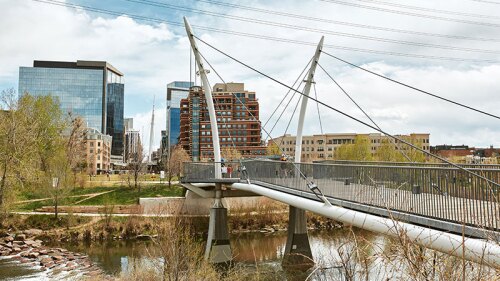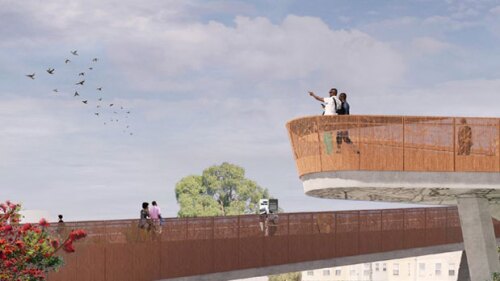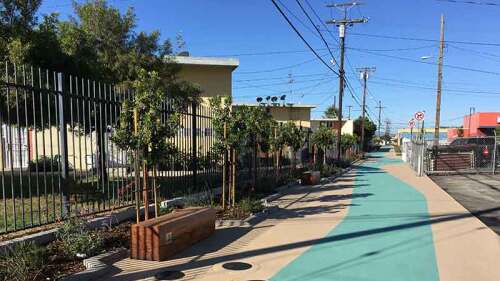Public art and open space are increasingly recognized as positive forces in urban economics. When the two are combined—like at Citygarden, the 2011 ULI Amanda Burden Urban Open Space Award winner—a powerful value generator for real estate emerges. Part municipal park, part sculpture garden, the 2.9-acre (1.1-ha) Citygarden in St. Louis, Missouri, stands as a powerful example of the regenerative power of art-infused urban open space. In the words of Mayor Francis Slay, “Citygarden is the most significant development to take place in St. Louis since the competition of the Gateway Arch nearly 50 years ago.”
For nearly a century, St. Louis’s Gateway Mall, a 1.1-mile (1.7-km) ribbon of grass and trees that unfurls westward from the Gateway Arch, represented little more than a missed opportunity. The largely uninviting mall served mostly as a barrier between the northern and southern portions of downtown. And after some old buildings on the site were razed about 15 years ago, the two blocks between Eighth and Tenth and Market and Chestnut streets were nothing more than vacant lawn, devoid of visual interest and human activity.
The Gateway Foundation, an arts-focused nonprofit organization that has funded a number of sculptures in St. Louis and sponsored lighting programs for the arch and the city’s iconic water towers, managed to transcend the issues that had long bedeviled the site. The foundation contributed approximately $25 million, not including the cost of the sculpture, to build the city-owned park on the two empty blocks between Eighth and Tenth streets. Built in 18 months, the park opened on schedule in July 2009. The public’s immediate strong embrace illustrated the positive and growing role that charitable foundations can play in bringing art and open space to the heart of cities and towns.
Designed by Charlottesville, Virginia–based Nelson Byrd Wolz Landscape Architects, Citygarden is rooted in the history, culture, and geography of St. Louis. Its landscaping draws on the area’s chief natural feature—its rivers—with a 550-foot-long (167-m-long) limestone arc wall that evokes the Mississippi’s and Missouri’s limestone bluffs, a sunken open space with shade trees known as the “the floodplain,” and a 1,100-foot-long (335-m-long) serpentine seat wall that mirrors the course of a winding river. The hill on its northwest corner references the Native American burial mounds that once dotted the local landscape, and pathways trace old city alleyways and property lines. The garden section—with native trees and grasses—is entirely distinctive to the region it inhabits.
| Before and After of Citygarden St. Louis, Missori. 2011 ULI Amanda Burden Urban Open Space Award winner |
Interactive sculptures—24 in all—are scattered throughout the site and include works by Fernand Leger, Aristide Maillol, Jim Dine, and Bernar Venet. Some observers worried during the planning stages that the sculptures would overcrowd the 2.9-acre (1.1-ha) space, but the concern proved unfounded, in part because each piece was sited with great care to create interest: whimsical white bunnies sit next to a modernist abstraction, a classical figure in repose lies alongside a playful human/bird hybrid. The park also includes a state-of-the-art LED video wall that displays art and films, a pool with a six-foot (1.8-m) waterfall, and a glass pavilion café. No signs forbid patrons to “keep off the art,” and children and adults alike climb on and pose with the art pieces. The successful infusion of public art at Citygarden has encouraged the city to fund art initiatives elsewhere in St. Louis: the city recently passed a new ordinance directing 1 percent of the money spent on capital improvement projects into a public art trust.
The urban open space has also had a positive effect on the surrounding real estate market and businesses. While the St. Louis market remains stagnant, local brokers and management companies indicate that the park is considered a strong amenity and a contributing factor to high occupancy rates. The St. Louis Convention Center and Visitors Commission reports that hotel room bookings are 18 percent ahead of the ten-year average, citing Citygarden as one of the reasons for the increase. Also, local shops and ground-floor retail establishments have benefited from the increased foot traffic, a sign that Citygarden is producing more than “island visits”—economic development parlance for visits to a single destination—and thus contributing to the vitality of downtown.
The urban park was planned with social equity in mind. Open every day, it is without walls or fences surrounding it or any prescribed points of entrance or exit. Through the use of ramps, paving coloration, and textured stone, the park is accessible to the abled and disabled alike. This diversity-by-design has been successful: as M. Peter Fischer, chairman of the Gateway Foundation, observed in his acceptance speech for the St. Louis Award, on an average day one sees “young adults, not so young adults, rich people, not so rich people, persons of virtually every color, people who like trees, flowers, sun, shade, tranquility, and sometimes chaos.”
Citygarden was the second winner of the annual ULI Amanda Burden Urban Open Space Award. For more information on the winner and prize, visit our webpage .


